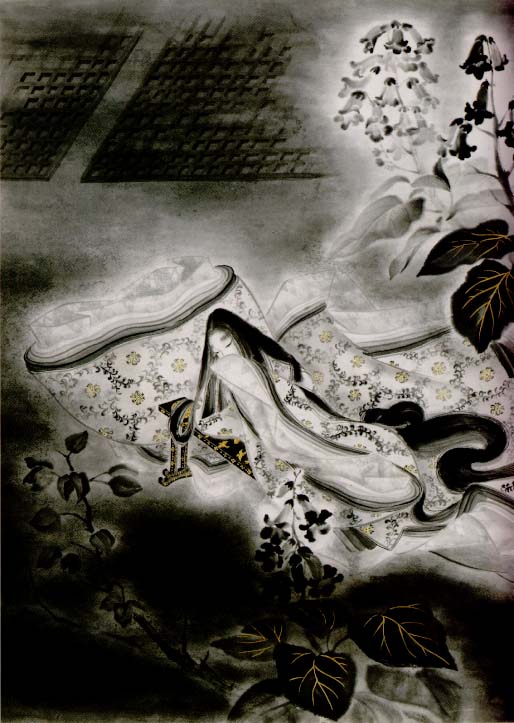01 — きりつぼ (桐壺 / Kiritsubo)
"The Paulownia Court" (S)
"The Paulownia Pavilion" (T)
Comments:
This chapter introduces many important narrative figures: Genji's father & mother, Genji's first wife, Genji's first love, Genji's best friend, Genji's primary political rival. It also introduces a two patterns that will recur throughout the story: first, emotional stress can have devastating effect on physical health and, second, a man’s excessive love for a woman has a dramatic and often negative effect on her life.
Story highlights:
Emperor Kiritsubo loves more than others a certain imperial attendant called The Haven (T) / a lady (S) (桐壺更衣, Kiritsubo no kōi). She is driven from court by the jealousy of other imperial attendants and consorts because she is treated with greater, if not excessive, kindness and love by the emperor than befits her rank. But she has given birth to an exceptionally beautiful boy who the emperor cherishes. This boy loses his mother (she dies from the psychological stress of her situation) and grandmother (she dies from the grief of losing her daughter) and it taken by the emperor to the palace to be cared for. He is, however, the object of active political hatred by the most influential of the emperor’s women, the Kokiden Consort (Kokiden no nyōgo), a highly protective mother of the current crown prince (the future Emperor Suzaku) who fears that the emperor might favor more than her own this child of his beloved and now deceased Kiritsubo Haven. To avoid an unfortunate career for his son, the emperor makes him a commoner, thus putting him on a different track than Kokiden’s son. He is given the family name Genji (源, Minamoto, a family name given sometimes to those of royal birth who are removed from the royal registry).
When Genji is 12, the emperor finds a replacement for Genji’s mother whom he had loved so deeply. This new love of the emperor is the daughter of a former emperor and so a princess (the Kiritsubo Haven was not royalty), and she will be called Fujitsubo (藤壷宮, Fujitsubo no miya). (Kiritsubo and Fujitsubo are both a complex of living quarters in the sprawling imperial palace grounds and the ladies are named after their location, as is Kokiden. Incidentally, "fuji" means wisteria and it is the same "fuji" as in the powerful family "Fujiwara" and while the wisteria flower is a range of colors from white to purple, it is associated with purple, as is the name of the later introduced Murasaki.) Fujitsubo enters the emperor's service at about age 16. Genji is profoundly attracted to her perhaps because of her beauty, perhaps because until he comes of age he is able to spend time directly with her, perhaps because of her deep resemblance to his mother, a connection that those around him, including his father, encourage him to make. (He has no personal recollection of what his mother looked like.) His love for her grows (and perhaps this is reciprocated but it is not explicitly stated).
At the end of this chapter, when Genji comes of age and is demoted to commoner status, he is married to Aoi (葵の上, Aoi no ue), also age 16, the daughter of the powerful and kind Minister of the Left. It is a good political marriage but Aoi seems uncomfortable with Genji's youthfulness (although it was common practice at that time for an aristocratic man's first wife to be a few years older than him).
Early in the chapter, Genji has been divined to be headed for an interesting but difficult future. It is noted at the end of the chapter that Genji was nicknamed by that diviner as "the shining lord" (光る君, hikaru kimi). (In English, Genji is sometimes referred to as "the Shining Prince" and this terms comes from this nickname given to him while he was, in fact, still of royalty. In general, though, it is something of a misnomer and Genji's commoner status should not be forgotten. His political calculations and his amorous adventurism would have very different shapes if he had remained a prince and remained a possible successor to the throne. Also, while in Japanese discussions he is often referred to as "Shining Genji" -- 光る源氏 -- this designation has extremely limited usage in the text itself.)
Reading notes:
Comparing Tyler and Seidensticker translations: Other than tone and minor matters, I do not feel there are substantial differences between the translations of this chapter. As will be the case throughout, Tyler translates closer to the level of word and sentence while Seidensticker operates a little closer to a "meta-text" or the sense of the story he is creating. With Tyler, close and careful reading will generate a sense of narrative while Seidensticker does some of this work for the reader, sacrificing sentence structure and departing a bit more than Tyler from the word-to-word sense of the original. Their approach to sobriquets for the narrative figures in the story is very different. However in this chapter that difference is limited.
Multimedia:
 |
|